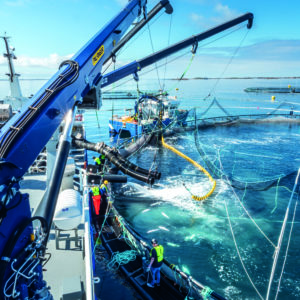Last Updated on November 28, 2019 by PALFINGER
PALFINGER MARINE is a reliable partner of the aquaculture industry. Our cranes are an ideal fit for fish farming vessels. We travelled to Norway to take a look at a business segment that offers huge potential.
Fish farming – also known as aquaculture – is big business in Norway. In 2017, the country’s fish farms supplied no less than 1,289,808 tonnes of fish for food. 94.5% of this amount was salmon, while rainbow trout comes in as a distant second at 5.1%. How does PALFINGER MARINE contribute to the industry that provides the tasty fish we all – or at least most of us – love? Well, many of the vessels involved are equipped with our cranes. Let us explain…

Live fish carrier Ro Fjell and two service vessels in operation in the Frøya/Hitra region.
THE VESSELS
Bernd Huemer, our Sales Manager for the Cranes Division EMEA, can shed some light on the topic: “The fishing industry generally uses two types of vessels. On the one hand, there are fishing vessels such as trawlers, purse seiners and longliners. On the other hand, we have fish farming vessels such as live fish carriers and service vessels. The latter offer enormous potential for PALFINGER MARINE.” When asked which of our products the shipyards involved favour, Bernd adds:
WE HAVE EQUIPPED MANY SERVICE VESSELS WITH OUR PK-SERIES, WHILE LIVE FISH CARRIERS ARE OFTEN EQUIPPED WITH OUR PTM-SERIES.
Bernd Huemer, Sales Manager - EMEA - Cranes
Well boats, as live fish carriers are also called, have grown in size considerably over the last five to ten years, mainly due to an increase in fish farming in Norway and Scotland. In the last five years, PALFINGER MARINE has sold more than 50 PTM cranes to live fish carriers in Norway. Apart from the Norwegian fish farming industry, Croatia is a well-established market for PALFINGER MARINE. Recently, we entered the fish farming markets in Canada, Chile and the Pacific Northwest.
- Live fish carrier Ro Fjell equipped with 7 PALFINGER MARINE cranes
- Live fish carrier Ro Fjell equipped with 7 PALFINGER MARINE cranes
- Service vessels equipped with our foldable knuckle boom cranes
A LONG LASTING PARTNERSHIP
We also sat down with Christian Hoff , the General Manager of Bergen Hydraulic, the exclusive PALFINGER MARINE crane dealer for Norway. Since the start of this close cooperation in 1992, the company has sold no less than 2,100 of our cranes. So Christian knows why the aquaculture players are so fond of our equipment: “The cranes are flexible, light and well designed. We are in close contact with all ship owners, naval architects and shipyards. I am proud to say that we have sold cranes to most service vessel and live fish carrier owners and builders based in Norway.” We were eager to find out more about how fish farming works and soon found out that Christian is the right person to ask. “In a perfect world, a live fish carrier travels to a fish farm unit only twice: to deliver smolt and to pick up grown fish one and a half years later. However, such vessels are also used for the delousing of aquaculture cages. These cages, of which there can be up to ten per location, hold as many as 150,000 salmon weighing between four and six kilograms.” What about the service vessels? Christian smiles: “As the name suggests, the service vessels are required for day-to-day maintenance work, but can also be used for anchoring and towing.”
ONBOARD THE WORLD’S LARGEST LIVE FISH CARRIER
PALFINGER MARINE is particularly proud of the fact that the Ro Fjell, the largest live fish carrier in the world, boasts five PTM 600 cranes, one PTM 1200 crane and one PS 23500 crane. Jan Huus, the Head of Aftermarket at Bergen Hydraulic, knows more: “The Ro Fjell, owned by Rostein, usually works for SalMar Farming in the Frøya/Hitra region. It can transport 700 tonnes of live salmon in two tanks with a combined volume of 4,500 cubic metres. The cranes we supplied are used for holding the two-way hoses and the net around the fish farming unit.” Rostein is the second largest well boat company worldwide. All of its 14 vessels are equipped with PALFINGER MARINE cranes. Given this close partnership, we had the opportunity to spend some time on the Ro Fjell in June this year. We took some spectacular photos and videos while on board. Come and see for yourself!




